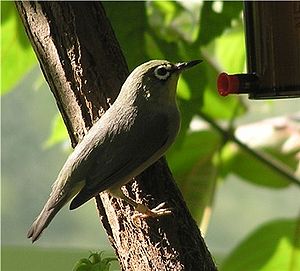Spectacle birds
| Spectacle birds | ||||||||||||
|---|---|---|---|---|---|---|---|---|---|---|---|---|

Ganges Spectacled Bird ( Zosterops palpebrosa ) |
||||||||||||
| Systematics | ||||||||||||
|
||||||||||||
| Scientific name | ||||||||||||
| Zosteropidae | ||||||||||||
| Bonaparte , 1853 |
The spectacled birds (Zosteropidae) are a songbird family in the order of the passerine birds (Passeriformes).
description
The birds are small and measure only 10 to 14 cm. The color of the upper side is usually gray-brown to olive-green, the belly is yellowish, gray or white. There are some larger types that are also duller in color. The genders do not differ externally. Most species have rings of white feathers around their eyes, which is what led to the German name. They have rounded wings, short legs and a short, pointed beak.
Occurrence
Spectacled birds inhabit tree-lined landscapes in the tropics of Africa , Asia , Australia and New Zealand . They are also often found on the islands in the Pacific .
Way of life
All spectacled birds are sociable, outside of the breeding season you can meet them in large flocks. They are sometimes even fought to prevent damage to gardens or plantations. The benefits are often overlooked as they decimate many pests. They are not good fliers and are often loyal to their location. Some species are also migratory birds, such as B. the rust-flank spectacle bird .
They feed on insects , berries and fruits . Your forked tongue is also well suited for absorbing nectar from flowers. They put their short, awl-shaped beak deep into the flower or they drill into the calyx from the outside.
The sexes can hardly be distinguished from the outside, but the males can be clearly recognized by their song during the breeding season. Since the song of many species is considered melodious, they are often kept as cage birds, e.g. B. the Ganges spectacled bird from India and Sri Lanka .
During the breeding season, each pair looks for their own breeding area. The nests are built on forks of branches or in bushes, they consist of fine blades of grass intertwined with cobwebs and other intertwined. The clutch consists of two to five eggs. They have a very short breeding season. The Cape spectacled bird only has to incubate its eggs for a little more than 10 days, which is the shortest known breeding season of all birds (as of 1981).
Genera and species (selection)
The group of spectacled birds is difficult to divide, most species are similar in appearance and way of life. An exception is e.g. B. the black ring spectacle bird living in Borneo at 4000 m altitude , whose eyes are not rimmed white but black. Often very similar forms live close together without mixing, so it is difficult to give information on the number of genera and species.
-
Apalopteron
- Bonin Spectacled Bird ( Apalopteron familiare )
-
Chlorocharis
- Black-ringed spectacle bird or black-eyed spectacle bird ( Chlorocharis emiliae )
-
Cleptornis
- Goldbrillenvogel ( Cleptornis marchei )
-
Heleia
- Spotted-breast- eyed bird ( Heleia muelleri )
-
Hypocryptadius
- Cinnamon-eyed bird ( Hypocryptadius cinnamomeus )
-
Lophozosterops
- Yellow- browed spectacled bird ( Lophozosterops superciliaris )
- Pinaiae ( Lophozosterops pinaiae )
-
Megazosterops
- Bronze goggle bird ( Megazosterops palauensis )
-
Oculocincta
- Dwarf goggle bird ( Oculocincta squamifrons )
-
Rukia
- Long-billed spectacled bird ( Rukia longirostra )
- Truk spectacle bird ( Rukia ruki )
-
Speirops
- Brown- eyed bird ( Speirops brunneus )
- Silberbrillenvogel ( Speirops leucophoeus )
-
Tephrozosterops
- Kakopibrillenvogel ( Tephrozosterops stalkeri )
-
Woodfordia
- Woodford bird ( Woodfordia superciliosa )
- Sanford bird ( Woodfordia lacertosa )
-
Zosterops
- Ceylon spectacle bird ( Zosterops ceylonensis )
- Buru-eyed bird ( Zosterops buruensis )
- Wallace bird ( Zosterops atrifrons )
- Sangihe spectacle bird ( Zosterops nehrkorni )
- Brown-headed spectacled bird ( Zosterops atriceps )
- Black-fronted spectacle bird ( Zosterops atricapillus )
- Macassar spectacled bird ( Zosterops anomalus )
- Somali spectacled bird ( Zosterops abyssinicus )
- Madagascar goggle bird ( Zosterops maderaspatanus )
- Yolk-breasted spectacled bird ( Zosterops mayottensis )
- Ganges Spectacled Bird ( Zosterops palpebrosa )
- Gray-coat spectacled bird ( Zosterops lateralis )
- Japanese eyeglass bird ( Zosterops japonicus )
- Cape spectacled bird ( Zosterops pallidus )
- Rust-flanked spectacled bird ( Zosterops erythropleurus )
- Mauritius spectacled bird ( Zosterops chloronothos )
- Mascarene spectacled bird ( Zosterops borbonicus )
- Mahé spectacled bird ( Zosterops modestus )
- White-breasted spectacled bird ( Zosterops albogularis )
- Lord Howe spectacle bird ( Zosterops strictua ) †
- Tagula-eyed bird ( Zosterops meeki )
- Arfak's spectacled bird ( Zosterops fuscicapilla )
- Karthalabrillenvogel ( Zosterops mouroniensis )
- Rein-eyed bird ( Zosterops conspicillatus )
- Samoan Spectacled Bird ( Zosterops samoensis )
proof
- The modern animal lexicon. Bertelsmann Publishing Group, Volume 2, 1981

